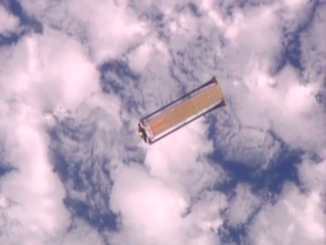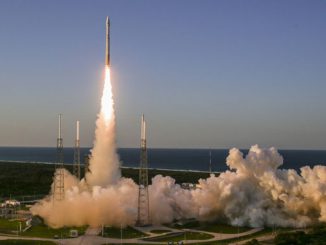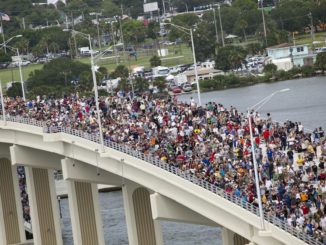
High winds predicted off the coast of Florida this week will keep SpaceX’s Crew Dragon Resilience spacecraft and its four-person crew in orbit until Saturday, three days after their previously scheduled return to Earth from the International Space Station.
NASA announced Monday that the return of the Crew Dragon Resilience spacecraft would be delayed.
The mission, known as Crew-1, was supposed to undock from the space station and re-enter the atmosphere Wednesday, targeting a parachute-assisted splashdown in the Gulf of Mexico off the coast of the Florida Panhandle.
In a statement, NASA said its teams and SpaceX managers agreed to move the Crew-1 mission’s undocking and return to Earth after reviewing weather forecasts in the Crew Dragon splashdown zones off the Florida coast. Forecasters currently predict wind speeds above safety criteria for splashdown.
NASA astronauts Mike Hopkins, Victor Glover, Shannon Walker, and Japanese mission specialist Soichi Noguchi are now scheduled to wrap up their mission with a splashdown in the Gulf of Mexico off the coast of Panama City, Florida, at 11:36 a.m. EDT (1536 GMT) Saturday.
The astronauts will board their Crew Dragon Resilience capsule Friday and close the hatch leading to the space station at about 3:50 p.m. EDT (1950 GMT) Friday. After a final check of forecast weather conditions in the splashdown zone, mission control will give a “go” for undocking of the Dragon capsule at 5:55 p.m. EDT (2155 GMT).
NASA said ground teams will continue monitoring weather conditions off the coast of Florida ahead of the Dragon spacecraft’s planned undocking Friday.
The automated departure maneuvers will carry the Dragon spacecraft a safe distance away from the space station, setting the stage for a retrograde braking burn to allow the ship to drop out of orbit for a scorching re-entry back into the atmosphere Saturday.
After descending to the sea under four parachutes, the astronauts will be helped out of their spaceship by SpaceX recovery teams. They will undergo preliminary medical checks before returning to shore by helicopter, then the crew will travel by airplane to their home base at NASA’s Johnson Space Center in Houston.
Assuming Hopkins and his crewmates come back to Earth on Saturday, they will be wrapping up 166 days off the planet since their Nov. 15 liftoff from NASA’s Kennedy Space Center in Florida.

SpaceX and NASA have seven splashdown zones available off the coast of Florida, with locations in the Gulf of Mexico near Pensacola, Panama City, Tallahassee, and Tampa. Three sites in the Atlantic Ocean northeast of Cape Canaveral, east of Daytona beach, and northeast of Jacksonville are also options.
The weather criteria for splashdown of a Crew Dragon spacecraft include wind speeds no greater than 12 mph, or about 10.5 knots. Managers also want the right mix of wave heights and wave periods, and a low probability of lightning.
The Crew Dragon Resilience spacecraft is in the final stretch of its first space mission. The Crew-1 flight is the first of six regular crew rotation missions to the International Space Station planned by SpaceX under a multibillion-dollar contract with NASA.
The Crew-1 astronauts are being replaced by four fresh crew members who docked at the space station Saturday aboard SpaceX’s Crew Dragon Endeavour spacecraft. The docking marked the first time two U.S. crew spaceships have been attached to the space station at the same time.
Crew-2 commander Shane Kimbrough, pilot Megan McArthur, Japanese astronaut Akihiko Hoshide, and European Space Agency mission specialist Thomas Pesquet will remain on the space station more than six months before the Crew-3 astronauts arrive at the space station in October.
Walker will hand over command of the space station’s Expedition 65 crew this week ahead of her return to Earth on the Crew Dragon Resilience capsule.

The Crew-1 mission’s flight back to Earth will conclude a busy month of crew rotations at the space station.
On April 9, a Russian Soyuz spacecraft lifted off from the Baikonur Cosmodrome in Kazakhstan with two Russian cosmonauts and one NASA astronaut. They replaced an outgoing crew of two Russians and one American, who landed on their Soyuz descent craft April 17.
Until the Crew-1 mission departs, the crew on the space station will have to be creative in finding sleeping quarters for the 11 astronauts and cosmonauts. The station has typically had six long-term crew members at a time, but the start of SpaceX crew missions allowed NASA to raise that to a full-time staff of seven.
The 11-person crew complement is the highest short-term staffing level on the space station since the penultimate space shuttle mission in 2011. The record number of crew members on the orbiting outpost at one time is 13 people, a level reached when shuttle astronauts joined long-term space station residents for one-to-two weeks at a time.
Joel Montalbano, NASA’s space station manager, said earlier this month that the space station’s life support systems could support the 11 residents for up to 20 days, if necessary. The limitations include the station’s oxygen generator and carbon dioxide removal system, he said.
“We have to fly some additional consumables for the extra crew members,” Montalbano said. “Of course, you have to look at sleeping arrangements. We’ll have some temporary sleeping arrangements for the crew members because we’ll have so many people.”
Some of the astronauts planned to sleep inside their Crew Dragon capsules, which serve as lifeboats during long-term stays at the space station.
Email the author.
Follow Stephen Clark on Twitter: @StephenClark1.



